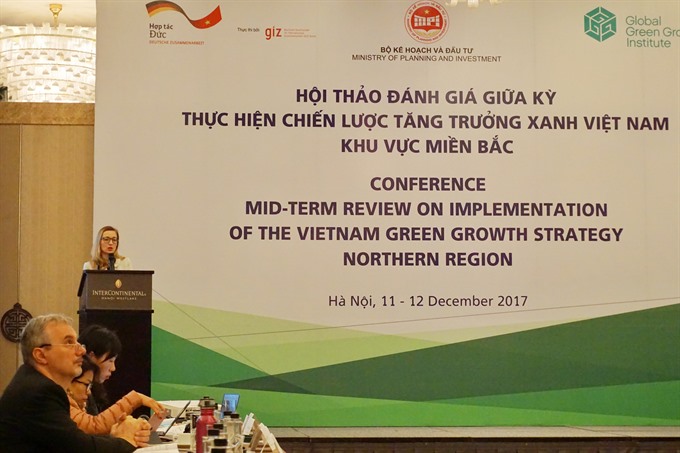 Society
Society

Only nine out of 25 provinces in the northern region have developed a green-growth strategy. Another two provinces are in the process of approving the innovations.
 |
| Justyna Grosjean, Project Manager at Deutsche Gesellschaft für Internationale Zusammenarbeit (GIZ), speaks at the meeting reviewing mid-term implementation of the national green growth strategy held on December 11-12 in Hà Nội. — VNS Photo Trọng Kiên |
HÀ NỘI — Only nine out of 25 provinces in the northern region have developed a green-growth strategy. Another two provinces are in the process of approving the innovations.
This was announced by Lê Đức Chung, a senior expert in the Ministry of Planning and Investment at a conference this week to review mid-term implementation of the national green growth strategy for 2014-2020 (VGG), which embraces three pillars - to reduce greenhouse gas emissions, "greening" production, and adopting "green" lifestyles and consumption.
According to Chung’s study, most of the provincial strategies are self-funded, or have no support from foreign partners specialising in this areas (USAID, UNDP, etc.) or the planning ministry. Therefore, they lack essential components, such as a greenhouse-gas inventory and a MACC (marginal abatement cost curve) – a way to illustrate low-carbon alternatives to business-as-usual economics.
In Việt Nam, a developing country, plenty of cheap and readily available fuel is needed to the economy expanding at 6-7 per cent a year, but green growth has not been prioritised in development plans.
However, the rising intensity of natural disasters and growing environmental pollution resulting from haphazard short-term economic gains is now making the "green growth" concept more popular.
Hà Nội, with its large population and dense traffic, is also aiming towards a green development model. The capital city has already adopted the national green-growth strategy, however, its own action plan will not be released until 2018.
City authorities noted several challenges in developing an action plan, including lack of central-level guidelines for green-growth development, a budget, lack of ways to implement monitoring, and difficulties in assessing separate emissions for each sector and industry.
Dr Nguyễn Thị Diễm Hằng, from Hà Nội’s Institute for Socio-economic development, added that it was difficult to convince stakeholders in the process, including the private sector, that green-development scenarios would benefit business.
She urged the Government to introduce legally binding requirements for localities instead of general guidelines and continue to provide help – from both international partners and domestic agencies – to provinces in crafting models tailored to their situation.
From another perspective, the northern port city of Hải Phòng has already built an action plan with the support of Japan’s Kitakyushu city and OECD. It is focused more on curbing pollution and emissions from the mining sector, promoting cleaner traffic and sustainable eco-tourism.
Phạm Văn Thành, vice-chairman of Hải Phòng People’s Committee, said that the city aimed to reduce emissions by 10 per cent by 2020 and by 25 per cent by 2030 compared to 2010.
One of the most pressing issues is the current “top-down” paradigm. This means that several goals and solution groups on energy saving, renewable energy, environment protection, and technology application have been introduced by the Government without input from businesses. However, it’s the businesses who must directly implement the goals.
Lê Đức Chung said this needed to be changed by starting with 1,000 "critical" businesses - large, important ones that are also heavy polluters in the list of commerce ministry, in addition to spearheading businesses in each locality.
Private involvement
Other experts said the public budget could only afford to cover 30 per cent of expenditure for green growth in the 2016-20 period, and it was essential that the remaining must be borne by the private sector.
“The public fund can and should serve only as a catalyst, creating favourable conditions for private investment,” Phạm Hoàng Mai, head of the science, education, natural resources and environment department, under the Ministry for Planning and Investment.
According to the Government, based on MACC, towards 2020, Việt Nam needed at least US$31 billion in investment for green growth in several polluting industries, except agriculture. As Việt Nam ratified the Paris agreement on climate change in 2016, the country needs to honour its commitment to cutback on greenhouse-gas emissions, which would require about $21 billion. However, public investment allocation (sourced from both State budget and ODA) for green growth in the 2016-2020 period only reached VNĐ2 trillion ($10 billion, adjustable to $10.7 billion), or around 30 per cent of the needed amount.
Yet, despite a fairly comprehensive system of policies and institutions to call for private sector investment and enthusiasm, many challenges stand in the way. Inertia in decision-making level, the limited number of start-ups in green energy, difficulties in accessing international green-development funds, and short-term vision over long-term ones are persistent problems.
A representative of the Việt Nam Steel Association called for "competent" consultancies that can deal with legal, technical, and financial issues on project proposals to foreign funds. He also complained of obstacles in accessing international funds, which had to be done via intermediary domestic commercial banks, which, as a result, hiked up the original preferential rates
One example, according to Chung from MPI, in the south-central provinces where solar potentials were significant, the authorities remained overly cautious on the promotion of this cleaner form of energy. Bình Thuận, for example, in its plan, officially accounts for 850 megawatt (MW), a meagre five per cent of the total output that interested private investors can produce. This means that the "superfluous" output will not be eligible to receive the province’s support and incentives.
On the other hand, private businesses, despite being aware of the benefits of green growth, remain reluctant to place their investments in what, in their eyes, are “risky and potentially disrupting changes”. Chung cited the case of offshore fishing companies hesitating to switch to LED lighting despite studies pointing out that such move could save $100 million a year.
The planning ministry said it wanted the National Assembly to be more persistent in asking Government’s agencies to follow through on green-growth tasks and commitments. It also called for tighter implementation of environmental taxes for polluters via carbon taxes, easier-to-access financial support and policies for stakeholders as well as monitoring mechanisms.
At the conference, UNDP representatives, Global Green Growth Institute and the German government’s international co-operation agency GIZ pledged to help northern provinces devise green-growth models exclusively for their localities. — VNS









